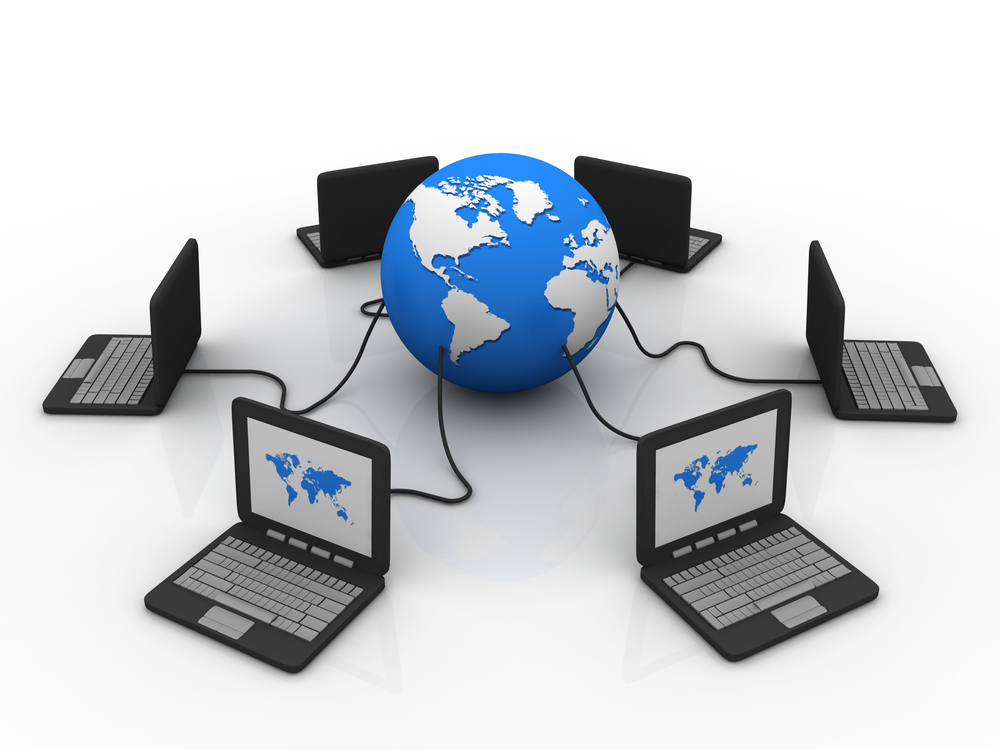LAN - Local Area Network or WAN - Wide Area Network
A local area network (LAN) supplies networking capability to a group of computers in close proximity
to each other such as in an office building, a school, or a home. A LAN is useful for sharing resources like
files, printers, games or other applications. A LAN in turn often connects to other LANs, and to the Internet
or other WAN (Wide area Network). Most LANs are built with relatively inexpensive hardware such as Ethernet
cables, network adapters, and hubs. Wireless LAN and other more advanced LAN hardware options also exist.
Specialized operating system software may be used to configure a local area network. For example, most flavors
of Microsoft Windows provide a software package called Internet Connection Sharing (ICS see below) that
supports controlled access to LAN resources. The term LAN party refers to a multiplayer gaming event where
participants bring their own computers and build a temporary LAN.
Examples:
The most common type of local area network is an Ethernet LAN. The smallest home LAN can have exactly two computers; a large LAN can accommodate many thousands of computers. Many LANs are divided into logical groups called subnets. An Internet Protocol (IP) "Class A" LAN can in theory accommodate more than 16 million devices organized into subnets.
LAN, WAN and Other Area Networks
One way to categorize the different types of computer network designs is by their scope or scale.
For historical reasons, the networking industry refers to nearly every type of design as some kind of area network.
Common examples of area network types are:
* LAN - Local Area Network
* WLAN - Wireless Local Area Network
* WAN - Wide Area Network
* MAN - Metropolitan Area Network
* SAN - Storage Area Network, System Area Network, Server Area Network, or sometimes Small Area Network
* CAN - Campus Area Network, Controller Area Network, or sometimes Cluster Area Network
* PAN - Personal Area Network
* DAN - Desk Area Network
LAN and WAN were the original categories of area networks, while the others have gradually emerged over many years
of technology evolution. Note that these network types are a separate concept from network topologies such as bus,
ring and star.
Internet Connection Sharing
* Multiple users can gain access to the Internet through a single connection by using Dial-Up Networking and local networking.
* Connected devices receive transparent network configuration by using Domain Name System (DNS) and Dynamic Host Configuration
Protocol (DHCP) to resolve Internet names. * Any IP-attached device can connect, including older Windows-based clients,
non-Windows-based clients, Microsoft Windows 98-based clients, and Microsoft Windows 2000-based clients, with no additional
client software required.
* Connected devices and software have comprehensive protocol support. For example, you can play Internet games without
additional configuration, or you can use Point-to-Point Tunneling Protocol (PPTP) and Virtual Private Networking (VPN)
to gain access to your corporate network.
Gear for Home LANs
802.11g Wireless Broadband Routers
The second generation of wireless routers for broadband home networks employs 802.11g technology. 802.11g wireless routers
supply more network bandwidth than their older 802.11b counterparts. That lets you add more computers to a network without
bogging it down. You'll also notice faster file sharing and printing. Consider cost, features, and brand when choosing your
wireless broadband router. Individual preferences ultimately make this a personal decision.
Broadband Routers - DSL or Cable
The broadband router combines the functions of a DSL or cable modem, a hub or switch, and a firewall. Broadband routers attempt to combine all of the essential features of home networking in one integrated, easy-to-use package. Differentiators for home "residential gateways" include specific features, reliability, cost, speed, and vendor reputation.
Securing LAN/WAN Networks
Network security is vital. Many applications (IBM 3270 telnet emulation, Telnet, ftp...) send unencrypted passwords across
the network. Although a network cannot be completely secured, the weakest links should be protected. It is not realistic to
expect the Network to be ever 100% secure. There are two principal tendencies in network security today:
New applications being developed are often designed so that they can transfer data securely across insecure networks. i.e.
some type of authentication / encryption is built-in. IP level encryption (for TCP/IP networks) offers a secure channel between
two machines, even over insecure networks.
Network security could easily be enhanced if Vendors replaced relics such as ftp, telnet and rlogin with more secure alternatives
such as ssh, if NIS+ and/or Kerberos clients were bundled with all major OSs and a secure email system such as pgp were fully
integrated into vendors email clients. But history shows that this is unlikely to happen..... Centralized network management is
important for maintaining network security. The Network (meaning both LAN and WAN) is analyzed here in terms of:
* Protocols: Netbios, TCP/IP, SNA, IPX, Decnet...
* Physical network types: leased lines, ISDN, X25, FDDI, Ethernet, ATM, radio, infra red, Microwave, GSM, satellite.
* Pure Network devices: routers, bridges, encryption units and modems. Firewalls are discussed in the next chapter.
What Happens?
Design
Services to provide the preparation and design work to configure and plan your network migration, upgrade or deployment.
Deploy
Services ensuring a timely and project-driven network installation and integration.
Support
Services which manage and maintain every part of your network environment.
Evolve
Services to provide the detailed analysis of current network and recommendations to maximize your investment and ensure you drive the performance, productivity, reliability and security of your network.
We are looking forward to meeting you and attending to all your internet needs.
Please give us a call at 315.553.2287 or 315.888.5320
